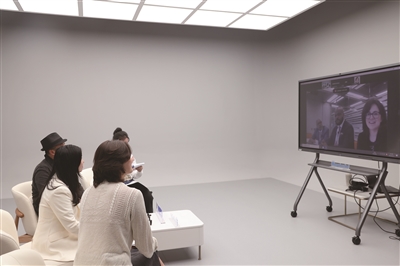
Hangzhou and Boston connecting online Photo Fang Jingyi

A Tale of Two Cities
By Daria Fominykh
A friendship spanning over 41 years between Hangzhou and Boston continues to flourish, revealing shared values through the engaging interview series "A Tale of Two Cities."
In the previous episode, we spotlighted marathon stars Becca Pizzi and Liang Xinde, illuminating the shared marathon spirit between these sister cities. Our latest episode dives into vibrant discussions on how each city develops and nurtures public art, exploring opportunities for mutual learning and collaboration.
We were honored to host an esteemed panel of guests for this episode, including Kara Elliott-Ortega, the Chief of Arts and Culture for the City of Boston; James Reginald Colimon, Deputy Director of Global Affairs and Protocol for the City of Boston; John Borders, Director of Tourism, Sports, and Entertainment for the City of Boston; and Professor Zheng Jing, Party Secretary and Associate Dean of School of Sculpture and Public Art at China Academy of Art.
Before delving deeper into our discussion, let's define public art. It consists of visual artworks placed in public spaces intended for the enjoyment and interaction of city residents and visitors. Public art can be found in various settings, including shopping malls, parks, playgrounds, and building walls. Often, it appears in surprising places and takes unconventional forms. Kara noted that public art can also be located on private land as long as it remains freely accessible to the public.
The purpose of public art
Zheng and Kara approached this question from distinct perspectives, reflecting their unique roles and experiences. Zheng, as an artist and curator, discussed how public art serves to transmit a city's culture, history, and spirit to everyone. He illustrated this point with examples from an exhibition he curated on the Qiandao Lake in Hangzhou, where each piece of art, designed to float on the lake, was deeply connected to the local history and culture of the area.
On the other hand, Kara, who focuses on integrating the arts within public policy and urban development, spoke about public art's role in fostering mental health, community connectivity, and social cohesion. She also emphasized its importance in giving artists a voice and promoting a sense of belonging among city residents. "Public art is essential for mental health, connectivity within a community, social cohesion, and simply for the feeling of joy. Artists should also have an opportunity to express themselves. We hope that in Boston, people have a sense of belonging—it is their city and where they belong," Kara noted.
Kara highlighted one of the unique aspects of Boston's public art scene: the murals. They are not only artistic expressions but also a narration of community stories. Boston even features a mural map showcasing over 100 artworks, demonstrating the unifying power of these pieces. "People are really excited to see artists working on murals in real time in their neighborhoods, and they also celebrate local artists getting these jobs," Kara added.
Finding common ground
One area where both cities find harmony is the use of light and illumination in public art. Professor Zheng, who specializes in this domain, frequently uses light as a medium for creative expression in his installations across Hangzhou and other cities in China.
Boston's representatives were inspired by these methods and revealed plans to support a large-scale light festival named ILLUMINUS. This festival aims to engage the community through various installations and culminate in citywide projection events in downtown Boston, creating a collective experience accessible to all. Kara emphasized the alignment in public art efforts between the two cities, highlighting a shared commitment to enhancing urban environments through innovative artistic expressions.
Opportunities for collaboration
Professor Zheng, with his extensive experience in international arts collaborations, suggested, "We can create targeted collaborative exhibitions that could occur simultaneously or consecutively in both cities. Additionally, having exhibitions that showcase each city as seen through the eyes of the other city's residents, supplemented by local festivals, photography, and short video collections, would be a great idea!"
As the conversation concluded, Zheng aptly summarized the artistic essence of both cities: "Boston's vibrant colors and murals embody elegant vitality, while Hangzhou's subdued colors, influenced by its cloudy weather and climate, foster a quiet appreciation of its underlying poetic and vibrant spirit." This exchange not only deepened mutual understanding but also highlighted the unique and resonant artistic expressions of both cities.
